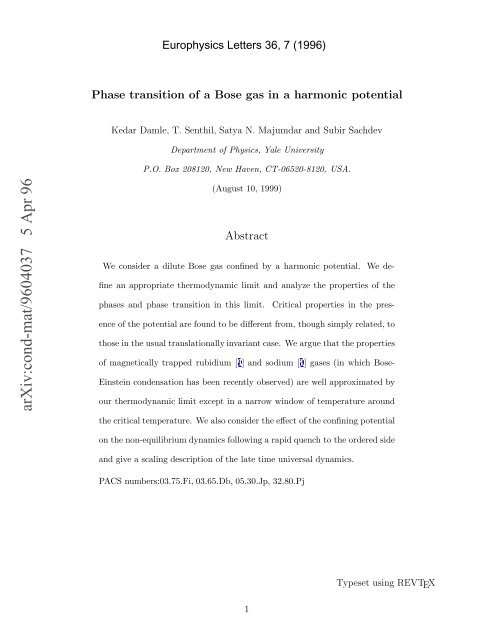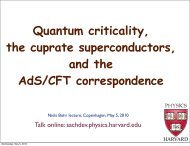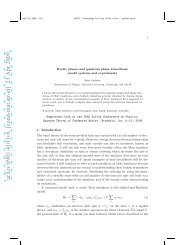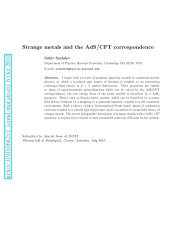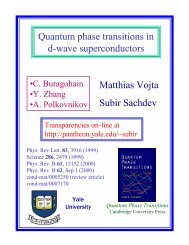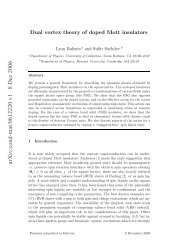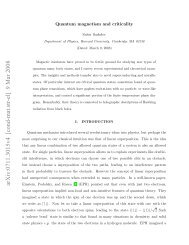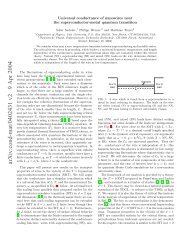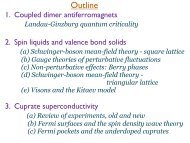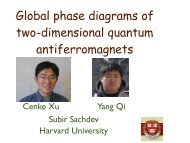Phase transition of a Bose gas in a harmonic potential
Phase transition of a Bose gas in a harmonic potential
Phase transition of a Bose gas in a harmonic potential
You also want an ePaper? Increase the reach of your titles
YUMPU automatically turns print PDFs into web optimized ePapers that Google loves.
<strong>Phase</strong> <strong>transition</strong> <strong>of</strong> a <strong>Bose</strong> <strong>gas</strong> <strong>in</strong> a <strong>harmonic</strong> <strong>potential</strong>Kedar Damle, T. Senthil, Satya N. Majumdar and Subir SachdevDepartment <strong>of</strong> Physics, Yale UniversityP.O. Box 208120, New Haven, CT-06520-8120, USA.arXiv:cond-mat/9604037 5 Apr 96(August 10, 1999)AbstractWe consider a dilute <strong>Bose</strong> <strong>gas</strong> conf<strong>in</strong>ed by a <strong>harmonic</strong> <strong>potential</strong>. We def<strong>in</strong>ean appropriate thermodynamic limit and analyze the properties <strong>of</strong> thephases and phase <strong>transition</strong> <strong>in</strong> this limit. Critical properties <strong>in</strong> the presence<strong>of</strong> the <strong>potential</strong> are found to be different from, though simply related, tothose <strong>in</strong> the usual translationally <strong>in</strong>variant case. We argue that the properties<strong>of</strong> magnetically trapped rubidium [1] and sodium [3] <strong>gas</strong>es (<strong>in</strong> which <strong>Bose</strong>-E<strong>in</strong>ste<strong>in</strong> condensation has been recently observed) are well approximated byour thermodynamic limit except <strong>in</strong> a narrow w<strong>in</strong>dow <strong>of</strong> temperature aroundthe critical temperature. We also consider the effect <strong>of</strong> the conf<strong>in</strong><strong>in</strong>g <strong>potential</strong>on the non-equilibrium dynamics follow<strong>in</strong>g a rapid quench to the ordered sideand give a scal<strong>in</strong>g description <strong>of</strong> the late time universal dynamics.PACS numbers:03.75.Fi, 03.65.Db, 05.30.Jp, 32.80.Pj1Typeset us<strong>in</strong>g REVTEX
Much excitement has been generated <strong>in</strong> the last few months by the observation <strong>of</strong> <strong>Bose</strong>-E<strong>in</strong>ste<strong>in</strong> condensation (BEC) <strong>in</strong> magnetically trapped alkali atoms [1]. S<strong>in</strong>ce the orig<strong>in</strong>alobservation <strong>of</strong> BEC <strong>in</strong> rubidium atoms, two other groups have reported evidence for the same<strong>in</strong> lithium [2] and sodium [3] atoms. A key feature <strong>of</strong> these experiments is the presence <strong>of</strong> aconf<strong>in</strong><strong>in</strong>g <strong>harmonic</strong> <strong>potential</strong> that the atoms feel. In this paper, we study the effects <strong>of</strong> sucha conf<strong>in</strong><strong>in</strong>g <strong>potential</strong> on the statistical mechanics <strong>of</strong> ideal and <strong>in</strong>teract<strong>in</strong>g <strong>Bose</strong> systems (weconf<strong>in</strong>e our attention to repulsive <strong>in</strong>teractions - so our results are not directly applicable tothe Lithium experiment). In particular, we study the effects <strong>of</strong> this conf<strong>in</strong><strong>in</strong>g <strong>potential</strong> on theequilibrium critical properties <strong>of</strong> the f<strong>in</strong>ite temperature phase <strong>transition</strong> at which the <strong>Bose</strong>condensate first appears. We show how to def<strong>in</strong>e a sensible thermodynamic limit <strong>in</strong> whichthe critical s<strong>in</strong>gularities are present; the experiments are, <strong>of</strong> course, <strong>in</strong> f<strong>in</strong>ite systems - this isaccounted for by f<strong>in</strong>ite-size scal<strong>in</strong>g crossover functions which smooth out the s<strong>in</strong>gularites, <strong>in</strong>a manner quite analogous to that for familiar phase <strong>transition</strong>s <strong>in</strong> translationally <strong>in</strong>variantsystems placed <strong>in</strong> a f<strong>in</strong>ite box. We will f<strong>in</strong>d that the exponents <strong>of</strong> the critical s<strong>in</strong>gularitiesare related, but not identical, to those <strong>of</strong> translationally <strong>in</strong>variant systems. The f<strong>in</strong>ite-sizescal<strong>in</strong>g crossover functions are expected to be new and not simply related to known crossoverfunctions. We also consider the non-equilibrium dynamics associated with the establishment<strong>of</strong> long-range order follow<strong>in</strong>g a rapid quench to the superfluid phase. We argue that recentresults [12] obta<strong>in</strong>ed for the case <strong>of</strong> a translationally <strong>in</strong>variant system placed <strong>in</strong> a f<strong>in</strong>ite boxmay be used to understand the effects <strong>of</strong> the conf<strong>in</strong><strong>in</strong>g <strong>potential</strong> on this dynamics.On general grounds, there is no true phase <strong>transition</strong> to a <strong>Bose</strong> condensed phase <strong>in</strong>the presence <strong>of</strong> a conf<strong>in</strong><strong>in</strong>g <strong>potential</strong> for a f<strong>in</strong>ite number <strong>of</strong> particles.Such a <strong>transition</strong>is expected to appear only <strong>in</strong> a suitable “thermodynamic” limit; we will argue here thatthe experimentally appropriate limit is one <strong>in</strong> which the frequency, ω, <strong>of</strong> the conf<strong>in</strong><strong>in</strong>g<strong>potential</strong> goes to zero, and the number <strong>of</strong> particles, N, to <strong>in</strong>f<strong>in</strong>ity, while keep<strong>in</strong>g Nω 3 ,the<strong>in</strong>teraction strength, and the temperature (T ) fixed. We will show that the critical properties<strong>in</strong> this limit can be understood by an application <strong>of</strong> the “local density approximation” <strong>of</strong>Oliva [4]. In this approximation, the system is viewed as a collection <strong>of</strong> homogenous semi-2
macroscopic blocks, each with it’s own local chemical <strong>potential</strong>. Each <strong>of</strong> these blocks canbe treated <strong>in</strong>dependently <strong>of</strong> the others, and have properties characteristic <strong>of</strong> large uniformsystems. The properties <strong>of</strong> the system with the conf<strong>in</strong><strong>in</strong>g <strong>potential</strong> can then be related tothe correspond<strong>in</strong>g properties <strong>of</strong> the usual translationally <strong>in</strong>variant systems. Many aspects <strong>of</strong>our general discussion below can be checked explicitly <strong>in</strong> a Hartree-Fock calculation [6]. Wethus obta<strong>in</strong> a complete understand<strong>in</strong>g <strong>of</strong> the properties <strong>of</strong> the system <strong>in</strong> the thermodynamiclimit. (In earlier treatments [4,5], this approach was used for an approximate treatment<strong>of</strong> the non-critical properties <strong>of</strong> the <strong>in</strong>homogenous <strong>Bose</strong> <strong>gas</strong>es, but the importance <strong>of</strong> thethermodynamic limit <strong>in</strong> justify<strong>in</strong>g it was not noted). For the phase <strong>transition</strong>, we estimateby the usual G<strong>in</strong>zburg criterion that the system crosses over to the critical non-ideal regimeonly at small deviations from criticality (|T − T c |/T c ≃ 10 −3 for the exist<strong>in</strong>g experimentalsystems); some properties <strong>of</strong> the system <strong>in</strong> this regime are quite significantly modified bythe presence <strong>of</strong> the <strong>potential</strong>. Further, we show that the experimental systems are quiteaccurately described by our thermodynamic limit except <strong>in</strong> a narrow w<strong>in</strong>dow <strong>of</strong> temperaturesnear the critical temperature, where f<strong>in</strong>ite-size crossovers need to be considered. However,this w<strong>in</strong>dow is somewhat bigger than the temperature range for non-ideal behaviour; thusthe crossover to non-ideal critical behaviour will be complicated by the presence <strong>of</strong> f<strong>in</strong>ite-sizeeffects.We will describe our results us<strong>in</strong>g the Hamiltonian (<strong>in</strong> second-quantized notation)∫ [ ¯h2H = d 3 x2m |∇ψ|2 +( 12 mω2 (x 2 + y 2 + λ 2 z 2 ) − µ)|ψ| 2 + u 2 |ψ|4 ](1)where m is the mass <strong>of</strong> the bosons, the <strong>in</strong>teraction strength u is related to the scatter<strong>in</strong>glength a by u =4π¯h 2 a/m, andλ is the anisotropy <strong>in</strong> the <strong>harmonic</strong> <strong>potential</strong>. When ω isf<strong>in</strong>ite, the system is conf<strong>in</strong>ed to a f<strong>in</strong>ite region and will not have a true phase <strong>transition</strong> toa phase with long-range order. We expect “thermodynamic” behaviour to emerge only <strong>in</strong>the limit <strong>in</strong> which ω is sent to zero and the number <strong>of</strong> particles to <strong>in</strong>f<strong>in</strong>ity. In the usualcase <strong>of</strong> a system conf<strong>in</strong>ed <strong>in</strong> a box, this is achieved by keep<strong>in</strong>g the density constant whilesend<strong>in</strong>g the box size to <strong>in</strong>f<strong>in</strong>ity.For the oscillator case, this suggests that we scale the3
number <strong>of</strong> particles N with the volume over which the system is conf<strong>in</strong>ed. This can beestimated at high temperatures (where <strong>in</strong>teractions and quantum effects may be neglected)to be ≃ (k B T/mω 2 ) 3 2 . Thus, we guess that the thermodynamic limit is def<strong>in</strong>ed by send<strong>in</strong>gω to zero while keep<strong>in</strong>g Nω 3 fixed. As shown below, this does turn out to be a perfectlysensible limit <strong>in</strong> which there is a true phase <strong>transition</strong> at a f<strong>in</strong>ite non-zero temperature andthe free energy per particle is f<strong>in</strong>ite.First consider the system <strong>in</strong> its high temperature phase. As ω goes to zero, the <strong>potential</strong>varies over a macroscopic length scale ∼ 1/ω. Divide the system up <strong>in</strong>to blocks, such that the<strong>potential</strong> does not vary significantly across any block. Each <strong>of</strong> these blocks is macroscopic<strong>in</strong> size and uniform. The correlation length <strong>in</strong> any block is some microscopic number (muchsmaller than the size <strong>of</strong> the block) determ<strong>in</strong>ed by the local chemical <strong>potential</strong>. The differentblocks can therefore be treated <strong>in</strong>dependently <strong>of</strong> each other. Furthermore, the properties<strong>of</strong> any block are well approximated by the thermodynamic behaviour <strong>of</strong> the correspond<strong>in</strong>guniform system. Extensive quantities such as the free energy are then a sum over the freeenergies <strong>of</strong> the <strong>in</strong>dividual blocks. For the total free energy F we thus haveF = ∑ ∫F block =blocksd 3 rF(⃗r), (2)where F(⃗r) is the free energy density <strong>of</strong> a block <strong>of</strong> size d 3 r centered at the po<strong>in</strong>t labelledby ⃗r. Note that we have replaced the sum over blocks by an <strong>in</strong>tegral, as the free energydensity varies slowly from one block to another.The only ⃗r and ω dependence <strong>of</strong> F(⃗r)is through the local chemical <strong>potential</strong> µ(⃗r) =µ − 1 2 mω2 (x 2 + y 2 + λ 2 z 2 ) and thereforeF(⃗r) =f(ωx, ωy, ωλz). ThusF = 1λω 3 ∫d 3˜rf(˜r) (3)where ˜x = ωx, ỹ = ωy and ˜z = λωz. Note that the function f(˜r) hasnoω dependence. Weimmediately see that the free energy per particle F/N is f<strong>in</strong>ite <strong>in</strong> the limit N →∞, ω → 0,Nω 3 fixed. Thus the properties <strong>of</strong> the high temperature phase are related trivially to thecorrespond<strong>in</strong>g properties <strong>of</strong> the uniform system.4
order parameter susceptibility, χ, (which is <strong>of</strong> physical importance <strong>in</strong> magnetic systems)varies as (T − T c ) 3 2 −ν(2−η) .Thisexponentispositive (approximately 0.18) imply<strong>in</strong>g that thesusceptibility is f<strong>in</strong>ite at the <strong>transition</strong> (even though there is a divergent correlation lengthassociated with the <strong>transition</strong>) <strong>in</strong> contrast to the uniform case.We now consider the ordered phase. This phase is characterised by a non-zero expectationvalue for the <strong>Bose</strong> field Ψ. The magnitude <strong>of</strong> this order parameter will be spatially<strong>in</strong>homogenous (due to the conf<strong>in</strong><strong>in</strong>g <strong>potential</strong>), while its phase will be constant. First, weargue that there is <strong>in</strong>deed a well def<strong>in</strong>ed ordered phase <strong>in</strong> the thermodynamic limit def<strong>in</strong>edabove. Aga<strong>in</strong>, we imag<strong>in</strong>e that the entire system is divided <strong>in</strong>to semi-macroscopic blocks asbefore. We expect that both the density and the magnitude <strong>of</strong> the order parameter haveshort range correlations and hence their values <strong>in</strong> each block are determ<strong>in</strong>ed by the localchemical <strong>potential</strong> [8]. This immediately implies that the total number <strong>of</strong> particles scales as1/ω 3 . Similarly, we also expect the free energy density to be determ<strong>in</strong>ed just by the localchemical <strong>potential</strong>, and hence the total free energy also scales as 1/ω 3 . Thus the free energyper particle is aga<strong>in</strong> f<strong>in</strong>ite <strong>in</strong> the thermodynamic limit.S<strong>in</strong>ce the local chemical <strong>potential</strong> is a maximum at the center <strong>of</strong> the trap, the magnitude<strong>of</strong> the order parameter will be the largest at the center and will decrease as one moves awayfrom the center.It eventually becomes zero when the local chemical <strong>potential</strong> becomessmaller than µ c . The position <strong>of</strong> this edge, denoted by ⃗r c ,isgivenbyµ(⃗r c )=µ c .Neartheedge, |〈Ψ〉| ∼ (µ(⃗r) − µ c ) β ∼ (r c − r) β where β ≃ 0.34 is the usual order parameter exponentfor the uniform system. This is an important po<strong>in</strong>t as it may be possible to study criticalproperties <strong>of</strong> the system by study<strong>in</strong>g it close to the edge <strong>of</strong> the condensate <strong>in</strong> the orderedphase.The fraction <strong>of</strong> particles <strong>in</strong> the k = 0 mode, n(k = 0) (which is <strong>of</strong> direct experimentalsignificance) is proportional to (ω 3 ∫ d 3 r|〈Ψ(⃗r)〉|) 2 <strong>in</strong> the thermodynamic limit. Asone approaches the critical po<strong>in</strong>t from the ordered phase, the spatial extent <strong>of</strong> the condensedregion shr<strong>in</strong>ks to zero as (µ − µ c ) 1 2 ∼ (T c − T ) 1 2 . The maximum value <strong>of</strong> theorder parameter (i.e. at r =0)vanishesas(µ − µ c ) β ∼ (T c − T ) β . This implies that6
n(k =0)∼ (T c − T ) 2(β+ 3 2 ) ∼ (T c − T ) 3.68 . An explicit calculation <strong>of</strong> the order parameterpr<strong>of</strong>ile at T = 0 with<strong>in</strong> a Hartree-Fock approximation, was performed <strong>in</strong> Ref. [9]. An extension<strong>of</strong> such a calculation to the critical regime [6] provides an illustration <strong>of</strong> the generaldiscussion above (see also Ref. [10]).As before, the free energy is determ<strong>in</strong>ed completely once the free energy density <strong>of</strong> theuniform system is known as a function <strong>of</strong> µ.Thus the low temperature specific heat isproportional to T 3 , like <strong>in</strong> the uniform case, though the prefactor will be different.The phase <strong>of</strong> the order parameter, <strong>of</strong> course, has long range correlations. Associatedwith slow variations <strong>of</strong> this phase, we have the usual sound wave. The character <strong>of</strong> thismode is not different from the uniform case as long as the wavelength is small compared toa typical block size. The sound wave velocity will be determ<strong>in</strong>ed <strong>in</strong> the usual way by thelocal superfluid density and compressibility. This spatial variation will cause the wave to be“refracted” as it propogates.The critical behaviour described above will become observable only <strong>in</strong> a w<strong>in</strong>dow aroundT C which is given by the usual G<strong>in</strong>zburg criterion. This predicts that the system crossesover to the critical regime when ξ ∼ λ 2 T /a where λ T =(¯h 2 /2mk B T ) 1 2 is the thermal deBroglie wavelength and a is the scatter<strong>in</strong>g length. This corresponds to |(T − T c )/T c |∼(a/λ T ) 2 ∼ 10 −3 − 10 −4 for the Rb [1] and Na [3] experiments. Outside <strong>of</strong> this w<strong>in</strong>dow <strong>in</strong>the high temperature phase, the behaviour <strong>of</strong> the system can be well approximated by thethermodynamic limit <strong>of</strong> the ideal <strong>Bose</strong> <strong>gas</strong> <strong>in</strong> a <strong>harmonic</strong> <strong>potential</strong> and the calculations <strong>of</strong>[11] are expected to apply.A small but non-zero value <strong>of</strong> ω leads to deviations from the theory described above,which is valid <strong>in</strong> the thermodynamic limit. “F<strong>in</strong>ite-size” corrections are most significantnear the critical po<strong>in</strong>t where the non-zero ω rounds <strong>of</strong>f any s<strong>in</strong>gular behaviour <strong>of</strong> physicalquantities. A crude estimate <strong>of</strong> the width <strong>of</strong> this region where f<strong>in</strong>ite-size effects are importantmay be obta<strong>in</strong>ed as follows: Near the bottom <strong>of</strong> the well, the correlation length variesappreciably over a length r ∼ √ (µ c − µ)/(mω 2 ).F<strong>in</strong>ite-size effects will be negligible so7
long as this length is much larger than ξ(r = 0).In the high temperature phase, byus<strong>in</strong>g the ideal bose <strong>gas</strong> expression for ξ(r = 0), this can be converted to the condition(T − T c )/T c < ¯hω/(k B T c ) ∼ 10 −2 . A similar estimate is expected to hold below T c as well.Note that this w<strong>in</strong>dow is at least an order <strong>of</strong> magnitude bigger than the temperature rangewhere the system crosses over to the critical regime. Thus “f<strong>in</strong>ite-size” effects will prohibitobservation <strong>of</strong> the true critical behaviour <strong>in</strong> the current range <strong>of</strong> experimental parameters.Increas<strong>in</strong>g the scatter<strong>in</strong>g length and/or decreas<strong>in</strong>g the frequency <strong>of</strong> the trap will enhancethe possibility <strong>of</strong> measur<strong>in</strong>g critical properties.So far we have restricted ourselves to the equilibrium properties <strong>of</strong> the system. However,an <strong>in</strong>terest<strong>in</strong>g question which may also be experimentally relevant [1] is: How does thecondensate grow <strong>in</strong> time to its f<strong>in</strong>al equilibrium value after a rapid quench <strong>in</strong> temperaturefrom above T c to below ? This non-equilibrium question has been addressed recently [12]for a translationally <strong>in</strong>variant dilute <strong>Bose</strong> <strong>gas</strong>. It was shown that the standard phenomenology<strong>of</strong> phase-order<strong>in</strong>g k<strong>in</strong>etics [13](which predicts, at late times, the existence <strong>of</strong> a s<strong>in</strong>gletime dependent length scale ∼ t 1 z ) can be used to obta<strong>in</strong> a scal<strong>in</strong>g form for the equal-timecorrelation function <strong>of</strong> the Boson field Ψ :G(r, r ′ ,t,L) ≡〈ψ ∗ (r, t)ψ(r ′ ,t)〉 = |〈ψ〉| 2 F ( |r − r′ |L, ctL ) (5)zwhere L is the l<strong>in</strong>ear size <strong>of</strong> the system, c is a scale factor that depends on the f<strong>in</strong>al temperature(or equivalently, the f<strong>in</strong>al chemical <strong>potential</strong>), 〈ψ〉 is the equilibrium order parameterat that temperature and |r − r ′ | is much larger than all microscopic scales <strong>in</strong> the problem.The value <strong>of</strong> z was numerically estimated to be close to 1 and it was argued that z shouldbe exactly equal to 1 [12].We now consider the effect <strong>of</strong> the conf<strong>in</strong><strong>in</strong>g <strong>potential</strong> on this dynamics.Imag<strong>in</strong>e, asbefore, splitt<strong>in</strong>g the system up <strong>in</strong>to many blocks (<strong>of</strong> size l ∼ 1/ω) such that the <strong>potential</strong>does not vary significantly with<strong>in</strong> any block. As long as t 1 z≤ l, the equal time correlationfunction with<strong>in</strong> each block scales as:G(r, r ′ ,t,ω)=|〈ψ(Rω)〉| 2 H(|r − r ′ |ω, c ′ (Rω)tω z ) (6)8
where R is the coord<strong>in</strong>ate <strong>of</strong> the centre <strong>of</strong> the block, c ′ is a scale factor that depends on thelocal chemical <strong>potential</strong> and the value <strong>of</strong> z is unchanged from the translationally <strong>in</strong>variantcase. Motivated by this we can now make the follow<strong>in</strong>g ansatz for the scal<strong>in</strong>g form validfor arbitrarily large values <strong>of</strong> t and |r − r ′ | (<strong>in</strong> particular, r and r ′ may belong to differentblocks):G = P (rω, r ′ ω, tω z ) (7)where z is the same as before. Notethatast →∞P must reduce to 〈ψ(r)〉〈ψ ∗ (r ′ )〉 whichis consistent as 〈ψ(r)〉 depends on r only through µ(ωr).The total number <strong>of</strong> particles <strong>in</strong> the k = 0 mode is proportional to ω 3 ∫ d 3 r ∫ d 3 r ′ P andthus satisfies the scal<strong>in</strong>g form:n(k =0,t)=ω −3 f(tω z ) (8)The fraction <strong>of</strong> particles <strong>in</strong> the k =0modeisgivenasn(k =0,t)/N =(1/(Nω 3 ))f(tω z ).The function f <strong>of</strong> course depends on the value <strong>of</strong> temperature we quench to and the value<strong>of</strong> the anisotropy λ. We thus conclude that the time dependence <strong>of</strong> n(k =0)/N for fixed T ,Nω 3 and λ but different values <strong>of</strong> ω should exhibit scal<strong>in</strong>g collapse at late times. For smallvalues <strong>of</strong> its argument f(x) ∼ x 3 z . For small enough ω (i.e for a large enough system) it maybe possible to observe a correspond<strong>in</strong>g w<strong>in</strong>dow <strong>in</strong> time <strong>in</strong> which the condensate fraction haspower-law growth n(k =0,t)/N ∼ t 3 z .In summary, we have presented a rather complete understand<strong>in</strong>g <strong>of</strong> the effects <strong>of</strong> theconf<strong>in</strong><strong>in</strong>g <strong>potential</strong> on the equilibrium properties <strong>of</strong> a dilute <strong>Bose</strong> <strong>gas</strong>. In particular, we havedemonstrated that the critical properties <strong>of</strong> the system <strong>in</strong> a conf<strong>in</strong><strong>in</strong>g <strong>potential</strong> are differentfrom but simply related to the uniform case. We have also provided a scal<strong>in</strong>g descriptionfor the late time universal dynamics follow<strong>in</strong>g a rapid quench to the ordered phase.This work was supported by NSF Grant No. DMR-92-24290 and DMR-91-20525.9
REFERENCES[1] M.H. Anderson, J.R. Ensher, M.R. Matthews, C.E. Wieman, and E.A. Cornell, Science269, 198 (1995)[2] C.C. Bradley, C.A. Sacket, J.J. Tollett, and R.G. Hulet, Phys. Rev. Lett., 75, 1687(1995)[3] K.B. Davis, M.-O. Mewes, M.R. Andrews, N.J. van Druten, D.S. Durfee, D.M. Kurn,and W. Ketterle, Phys. Rev. Lett., 75, 3969 (1995)[4] J. Oliva, Phys. Rev. B39, 4197 (1989) and references there<strong>in</strong>.[5] T.T. Chou, C.N. Yang and L.H. Yu, prepr<strong>in</strong>t cond-mat/9602153[6] Kedar Damle, T. Senthil, Satya N. Majumdar and Subir Sachdev, unpublished.[7] This is generally the case when the specific heat exponent is negative as happens here.See M.E. Fisher, Phys. Rev., 176, 257 (1968)[8] For this to be true, we must require that the size <strong>of</strong> any block is much bigger than thelocal Josephson correlation length.[9] G. Baym and C. Pethick. Phys. Rev. Lett., 76, 6 (1996).[10] V.V. Goldman, I.F. Silvera and A.J. Leggett, Phys. Rev. B, 24, 2870 (1981).[11] V. Bagnato, D.E Pritchard, and D, Kleppner, Phys. Rev. A 35, 4354 (1987).[12] K. Damle, S.N Majumdar, and S. Sachdev, prepr<strong>in</strong>t cond-mat/9511058[13] A.J. Bray, Advances <strong>in</strong> Physics, 43, 357 (1994).10


